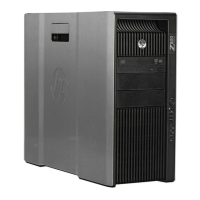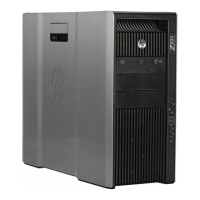might present two audio hardware choices. If you do not hear sound through the speakers, one possible
reason is that the graphics card (default) is selected for audio output instead of the DisplayPort. Check the
audio settings (for example, Sound in gnome-control-center).
In some systems, embedded Intel HD graphics may also present a similar HDMI audio device that can be used
through the DisplayPort interface. No proprietary driver is needed for this device, just a sufficiently recent
kernel.
Network cards
All HP workstations include one or two integrated network interface controllers. Some support optional NICs.
Most Linux distributions have drivers for these interfaces.
Hyper-Threading Technology
The Z Series Workstations support Hyper-Threading Technology (HTT), an Intel technology that improves
processor performance by enabling the processor to simultaneously perform multiple tasks. The operating
system treats an HTT-enabled processor as two virtual processors and shares the workload between them
when possible. This feature can be used only if the operating system support multiple processors and is
specifically optimized for HTT.
To enable HTT:
1. During startup, press F10 to enter Computer Setup (F10) Utility.
2. Select Advanced > Performance Options.
3. Set Intel Hyper-Threading Technology to Enable, and then press F10 to exit the menu.
4. Select Main > Save Changes and Exit.
5. Restart the system to enable HTT.
NOTE: On most recent Linux distributions (including RHEL 6, SLED 11, and updates to those streams), the
kernel automatically detects that HTT is enabled and works correctly.
NVIDIA Graphics Workstations
Some workstation configurations come with NVIDIA Quadro graphics hardware. HP recommends the use of
NVIDIA drivers for best results on Linux systems.
HP provides recommended versions of the drivers with RPM-compatible installers for RHEL and SLED
distributions. These are available from the HP Installer Kit for Linux and from workstation driver repositories
on hp.com. When HP installers are used, their contents and documentation links are located in the /opt/hp/
nvidia folder.
When installing Linux on a workstation that contains an NVIDIA card, administrators should select a VESA-
compatible driver to avoid the instability that is experienced with some open-source versions of the Nouveau
and DRM drivers.
Open-source versions of Nouveau drivers and NVIDIA drivers cannot coexist in the same runtime environment
because they use the same hardware resources. If administrators create their own Linux environments using
NVIDIA drivers but choose not to use HP-packaged versions, HP recommends that they manually append the
following boot loader parameters to properly suppress the Nouveau driver at runtime (grub example below):
kernel /vmlinuz ... rdblacklist=nouveau nouveau.modeset=0
This action is applied by HP installers but must be applied/restored under other circumstances.
Network cards 103

